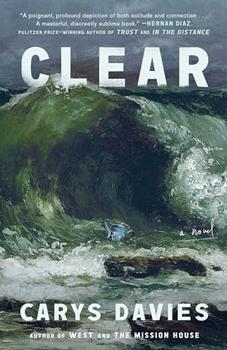Summary | Excerpt | Reviews | Readalikes | Genres & Themes | Author Bio
The True Story of the Man Who Unlocked the Secrets of the Aurora Borealis
by Lucy Jago

Critics' Opinion:
Readers' Opinion:
First Published:
Sep 2001, 320 pages
Paperback:
Oct 2002, 320 pages
From Chapter 1
Odin's Messengers
14 October 1899
Finnmark, Northern Norway, within the Arctic Circle
It is true of the northern lights, as of many other things of which we have no sure knowledge, that thoughtful men will form opinions and conjectures about it and will make such guesses as seem reasonable. But these northern lights have this peculiar nature, that the darker the night is, the brighter they seem, and they always appear at night but never by day, and rarely by moonlight. They resemble a vast flame of fire viewed from a great distance. It also looks as if sharp points were shot from this flame up into the sky, they are of uneven height and in constant motion, now one, now another darting highest; and the light appears to blaze like a living flame . . .
--Kongespeilet (The King's Mirror), c. 1220-30, Norse epic
It was ten in the morning and -25° Celsius when the group left the small mining town of Kaafjord for the summit of Haldde Mountain, Haldde being a Lappish word for "guardian spirit." The cold should have scattered the clouds but halfway to the top the wind engulfed the men in blinding eddies of snow and ice. Their guide, Clement Isaakson Hætta, was a Lapp who had abandoned the traditional activity of herding reindeer to become the local postman serving the few Norwegians, Swedes, and immigrant workers from Finland, the Kvens, living in this northerly outpost. Short, with bandy legs, he bent his body at the hips into a right angle and pushed on through the storm like a swaying battering ram. Firmly wrapped around his wrist were the leather reins of the leading reindeer that was struggling to pull a sled piled high with a bizarre cargo of instrument boxes, trunks, and tripods. Seven reindeer, similarly yoked, were lashed behind the leader, and roped to them were five huddled figures.
Directly behind Hætta was the instigator of the expedition, Kristian Olaf Birkeland. He yelled to the guide above the screeching wind wanting to know whether it was safe to continue. He could not hear the response, as the storm scrambled Hætta's words and Birkeland was partly deaf from conducting noisy radio-wave experiments as a student. Festooned with reindeer skins, he appeared shorter than his five feet five inches. Only thirty-one years old, he was already balding across the dome of his fine-boned scalp. The snow stuck to his round spectacles but he had long given up scraping ice off the lenses and instead squinted between the rims and his fur hood. This unlikely adventurer had been made a professor of Norway's only university one year previously. He was the youngest of his colleagues in the Faculty of Science and Mathematics, his prophetic genius as a scientist emerging in his twenties when he solved problems that had defeated some of the brightest minds in Europe. Despite his youth, Birkeland was not a fit man; he loathed physical hardship and was more accustomed to long hours in the laboratory, hunched over diagrams and experiments. It was a comment on his devotion to scientific discovery that he was stranded on a mountain in eighty-kilometer-an-hour winds that howled continuously.
The storm was worsening; the men had been walking for six hours and had covered a distance that would take only two in good conditions. The guide shuffled onward, chewing on black tobacco, damp wads of which he spat into the wind. To reach the summit of the mountain, and the hut that would provide them with shelter, it was necessary to leave the narrow plateau they were traversing and climb the exposed mountainside. The peak they were heading toward was engulfed in a mass of swirling snow and ice as dense as black smoke.
Roped behind a breathless Birkeland came Bjorn Helland-Hansen, a gifted student in the medical department of Christiania University who was training to be a surgeon. Talented in science as well as medicine, he had attended Birkeland's lecture course and been inspired to join him on this adventure. He had just celebrated his twenty-second birthday. Tied to him was Elisar Boye, a Latin scholar who had been the first to volunteer for the expedition, presenting himself just a few hours after Birkeland posted a notice on the boards in the main hall of the university, requesting strong and able science students for a unique expedition to the Arctic Circle. At first Birkeland had thought that a Latin graduate would be of little use to him on a scientific mission, but Boye explained that he had achieved the best mark possible in mathematics, and eventually Birkeland relented in the face of the young man's enthusiasm. Boye looked much younger than his twenty-two years, with a smooth, pale complexion and clear blue eyes, on this day hidden inside his reindeer hood. He had stopped trying to see where he was going through the lashing snow and simply followed the direction of the tugging rope. Behind Boye came Kristoffer Knudsen, a twenty-three-year-old telegraphic engineer who had been working for the Norwegian railway until Birkeland lured him away with promises of adventure and pioneering science. He did not know the other members of the group and was the quietest when they began the ascent. As the storm intensified, he retreated ever further into his jacket and squinted at the ground immediately before his feet through the hairs of his hood. The tallest in the party, Sem Sæland, brought up the rear. Just turned twenty-five, Sæland had studied mathematics, astronomy, physics, and chemistry at the university, then traveled to Iceland, where he spent a year teaching before returning to Christiania University for further studies. There he met Birkeland, and was so interested in the professor's ideas that he had volunteered to join him on his expedition. Sæland repeatedly checked the knot in the rope linking him to the others as the driving snow was so thick he could see no more than a few centimeters beyond his nose.
From The Northern Lights: The True Story of the Man Who Unlocked the Secrets of the Aurora Borealis, by Lucy Jago. © September 25, 2001, reprinted by permission of the publisher, Knopf.





The Flower Sisters
by Michelle Collins Anderson
From the new Fannie Flagg of the Ozarks, a richly-woven story of family, forgiveness, and reinvention.

The House on Biscayne Bay
by Chanel Cleeton
As death stalks a gothic mansion in Miami, the lives of two women intertwine as the past and present collide.

The Funeral Cryer by Wenyan Lu
Debut novelist Wenyan Lu brings us this witty yet profound story about one woman's midlife reawakening in contemporary rural China.
Your guide toexceptional books
BookBrowse seeks out and recommends the best in contemporary fiction and nonfiction—books that not only engage and entertain but also deepen our understanding of ourselves and the world around us.